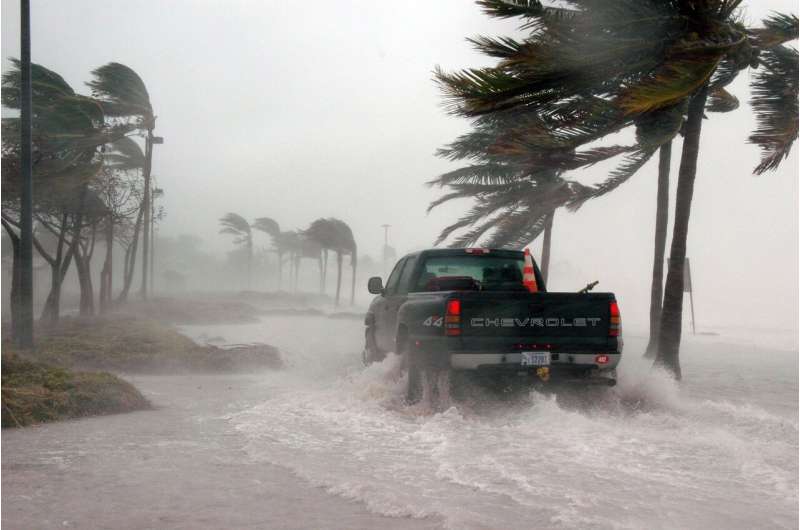Wind-related hurricane losses for homeowners in the southeastern US could be nearly 76% higher by 2060

Gaby Clark
scientific editor

Andrew Zinin
lead editor

Hurricane winds are a major contributor to storm-related losses for people living in the southeastern coastal states. As the global temperature continues to rise, scientists predict that hurricanes will get more destructive—packing higher winds and torrential rainfall. A new study, in the journal Risk Analysis, projects that wind losses for homeowners in the Southeastern coastal states could be 76% higher by the year 2060 and 102% higher by 2100.
University of Illinois civil engineer Eun Jeong Cha and her colleague Chi-Ying Lin used machine learning to simulate the impact of future hurricanes on wooden single-family homes with concrete masonry in Texas, Louisiana, Mississippi, Alabama, Florida, Georgia, South Carolina, and North Carolina.
Over the last decade, these states have been hit hard by destructive storms like Hurricane Irma (2017) and Hurricane Helene (2024). Helene's estimated total costs—which included damages from record-breaking flooding in western Carolina—were $78.7 billion.
"These states experience the highest hurricane activity and associated wind-related losses in the U.S.," says Cha. "They represent a critical region for understanding how climate change may alter hurricane risk, especially given their large coastal exposure and growing population centers."
Worst-case scenario
Cha's simulation of future losses from increasing hurricane winds and rainfall utilizes projections based on the worst-case scenario of global warming from the Intergovernmental Panel on Climate Change (IPCC). Known as RCP8.5, this scenario represents the highest possible greenhouse gas emissions in the absence of policies to combat climate change. It estimates that the earth's average global surface temperature will be 2.0° C higher by 2065 and 3.7° C higher by 2100 (relative to the 1986–2005 baseline).
"The worst-case scenario is widely used to explore high-impact possibilities for long-term planning and resilience studies," says Cha. "We view it as a stress-test scenario for hurricane wind risk."
Under this scenario, the simulation projected that, in the eight southeastern coastal states:
- Losses from wind and rain-ingress (when water enters a building) will be 49–76% higher by 2060 and 71%–102% higher by 2100.
- Hurricane wind speeds in Texas will be 14% higher in the 2050s compared to present-day levels.
- Texas will experience the highest increase in expected losses, followed by the region of Louisiana, Mississippi, and Alabama.
- Some inland counties, such as Charleston, South Carolina, may experience a relatively large percentage increase in projected risk.
At the county level, Cha and her colleagues found variations of hurricane risk associated with climate change, along with differences in regional preparation for hurricane wind hazards. The increasing vulnerability of the county of Charleston, South Carolina, may stem from a combination of projected increases in hurricane intensity, low historical exposure, and infrastructure that has not been stress-tested under more extreme wind and rain conditions.
"Within a state, climate change impact varies from coastal to inland counties," says Cha. "The discrepancies we found emphasize the necessity of vast regional risk assessment for federal- and state-level resource allocation and risk mitigation planning, considering the impact of climate change."
Insurance models need to account for heavier rainfall
Hurricane winds account for more than 40% of storm-related losses in the residential sector, causing $14 billion in expected annual costs to the U.S. economy, according to a 2019 report from the Congressional Budget Office. Yet most hurricane models used by insurance companies fail to consider the impact of climate change. In particular, says Cha, "rain-ingresses are often overlooked in risk assessments." This is why her study considered damages from both stronger winds and heavier rain from future hurricanes in the southeastern coastal states.
Another also recently published in Risk Analysis focuses on the connection between extreme rainfall and extreme insurance claims. Yue Shi, a Ph.D. candidate at the Norwegian School of Economics conducted a study of how extreme rainfall and climate-related events affect home insurance claims. Like Cha, she found increasing risk over time and significant geographical differences—pointing to a need for new insurance models as the climate gets wetter.
Accurately estimating hurricane hazards and resulting losses is essential, says Cha. "Our findings contribute significantly to our understanding of climate change impacts on hurricane risks, providing valuable insights for policymakers, urban planners, and the insurance industry."
More information: Eun Jeong Cha et al, Evaluating the impact of climate change on hurricane wind risk: A machine learning approach, Risk Analysis (2025).
Yue Shi, Assessing the dependence between extreme rainfall and extreme insurance claims: A bivariate peak over threshold method, Risk Analysis (2025).
Journal information: Risk Analysis
Provided by Society for Risk Analysis




















